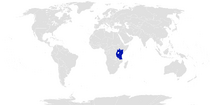| East African Federation Shirikisho la Afrika Mashariki (Swahili)
| |||||
|---|---|---|---|---|---|
| |||||
|
Motto: One People One Destiny | |||||
|
Anthem: Anthem of the East Africans | |||||
 Location of the East African Federation | |||||
| Capital | Arusha | ||||
| Largest city | Dad Es Salaam | ||||
| Official languages | English and Swahili | ||||
| Demonym | East African | ||||
| Government | Federation | ||||
• President of East Africa |
Kirunda Kivejinja | ||||
| Legislature | East African legislative assembly | ||||
• Water (%) |
4.9 | ||||
| Population | |||||
• 2016 estimate |
168,848,000 (8th) | ||||
| GDP (PPP) | 2018 estimate | ||||
• Total |
US$ 439.039 billion (36th) | ||||
| GDP (nominal) | 2018 estimate | ||||
• Total |
US$ 155.189 billion (57th) | ||||
| Gini (2018) |
45.5 medium · 48th | ||||
| HDI (2018) |
0.676 medium · 97th | ||||
| Currency | East African Shilling (EAS) | ||||
| Time zone | EAT (+3) | ||||
• Summer (DST) |
(UTC−) | ||||
| Date format | mm-dd-yyyy | ||||
| Drives on the | right | ||||
| Calling code | +255 | ||||
| ISO 3166 code | EF | ||||
The East African Federation, or just East Africa or EAF for short, is a Federation in east Africa. It borders Ethiopia to the north, Mozambique and Malawi to the south, the Democratic Republic of the Congo to the west, and the Indian Ocean to the east.
History[]
In the early 1960s, the nations of Tanganikya, Zanzibar, Uganda, and Kenya agreed to unite into a union known as the “East African Federation”. The New nation gained international recognition world wide, along with British recognition.
Poverty and Rise of the East African Tiger[]
Although the initial ideas of a united East Africa were successful, and the government initially popular with their citizens, the East African Federation almost immediately fell into hardship. The British left the nation of East Africa with leaders who had little experience in good leadership, let alone politics, not to mention a majority of the leaders of the new nation were used by the British to control their subjects, and quell rebellions, leading to these leaders having no experience with freedom and democracy. East Africa was truly in a terrible state. It wasn’t until the late 1970s and Early 80s that things got better. A man by the name of “Sesko Melene” was able to take control of the country by climbing the ranks, as getting to office the Democratic way was nearly impossible. Under Sesko, new reforms to the economy were made, with many government owned companies being privatized, and many small and collapsing private businesses given many loans that didn’t need to be paid back. Sesko’s regime encouraged private business, and under Sesko, elections returned, with him enacting the death penalty for politicians messing with the election results (which was later reduced to 20 years in prison). Sesko’s reforms to the economy also included major industries such as electricity, water and transportation state owned which in turn made any faults in these industries the government’s fault. Sesko, under his New Democratic system, won re-election after reelection, until 1987 where he announced the end of infinite terms, and the start of new term limits, which lasted 4 years, along with limits to executive power, which wouldn’t allow someone to do what Sesko did. After these major and well needed reforms, East Africa boomed, and soon it became one of the best economies in Africa.
The 90s and the accession of Burundi and Rwanda[]
The Early 90s started out with a new democratically elected leader of the East African Federation, and Two new countries wanting to be apart of the Federation. These two countries were Rwanda and Burundi. These 2 countries economies were in shambles, and along with ethnic tensions, were far from stable states. These 2 countries requested to join the East African Federation as full fledged states, and were accepted as long as they would treat their people as equals, which they reluctantly agreed too. More to be added.


